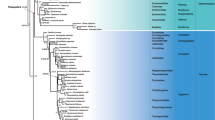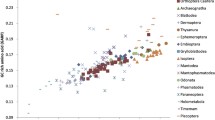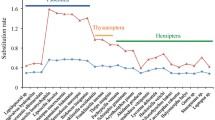Abstract
The current views on the phylogeny of arthropods are at odds with the traditional system, which recognizes four independent arthropod classes: Chelicerata, Crustacea, Myriapoda, and Insecta. There is compelling evidence that insects comprise a monophyletic lineage with Crustacea within a larger clade named Pancrustacea, or Tetraconata. However, which crustacean group is the closest living relative of insects is still an open question. In recent phylogenetic trees constructed on the basis of large gene sequence data insects are placed together with primitive crustaceans, the Branchiopoda. This topology is often suspected to be a result of the long branch attraction artifact. We analyzed concatenated data on 77 ribosomal proteins, elongation factor 1A (EF1A), initiation factor 5A (eIF5A), and several other nuclear and mitochondrial proteins. Analyses of nuclear genes confirm the monophyly of Hexapoda, the clade uniting entognath and ectognath insects. The hypothesis of the monophyly of Hexapoda and Branchiopoda is supported in the majority of analyses. The Maxillopoda, another clade of Entomostraca, occupies a sister position to the Hexapoda + Branchiopoda group. Higher crustaceans, the Malacostraca, in most analyses appear a more basal lineage within the Pancrustacea. We report molecular synapomorphies in low homoplastic regions, which support the clade Hexapoda + Branchiopoda + Maxillopoda and the monophyletic Malacostraca including Phyllocarida. Thus, the common origin of Hexapoda and Branchiopoda and their position within Entomostraca are suggested to represent bona fide phylogenetic relationships rather than computational artifacts.
Similar content being viewed by others
References
Ruppert E.E., Fox R.S., Barnes R.D. 2004. Invertebrate Zoology: A Functional Evolutionary Approach, 7th ed. Vol. 3: Arthropods. Belmont, CA: Brooks/Cole-Thomson Learning.
Kluge N.Yu. 2000. Sovremennaya sistematika nasekomykh (Modern Insect Taxonomy). St. Petersburg: Lan’.
Dogel V.A. 1981. Zoologiya bespozvonochnykh (Invertebrate Zoology). Ed. Polyanskii Yu.I. Moscow: Vysshaya Shkola.
Turbeville J.M., Pfeifer D.M., Field K.G., Raff R.A. 1991. The phylogenetic status of arthropods, as inferred from 18S rRNA sequences. Mol. Biol. Evol. 8, 669–686.
Ballard J.W.O., Ballard O., Olsen G.J., Faith D.P., Odgers W.A., Rowell D.M., Atkinson P. 1992. Evidence from 12S ribosomal RNA sequences that onychophorans are modified arthropods. Science. 258, 1345–1348.
Friedrich M., Tautz D. 1995. Ribosomal DNA phylogeny of the major extant arthropod classes and the evolution of myriapods. Nature. 376, 165–167.
Averof M., Akam M. 1995. Insect-crustacean relationships: Insights from comparative developmental and molecular studies. Phil. Trans. R. Soc. London B. 256, 183–235.
Giribet G., Carranza S., Baguñà J., Riutort M., Ribera C. 1996. First molecular evidence for the existence of a Tardigrada + Arthropoda clade. Mol. Biol. Evol. 13, 76–84.
Boore J.L., Lavrov D.V., Brown W.M. 1998. Gene translocation links insects and crustaceans. Nature. 392, 667–668.
Aleshin V.V., Petrov N.B. 1999. Implicaciones del gen 18S ARNr en la evolución y filogenia de los Arthropoda. In: Evolución y Filogenia de Arthropoda. Boletin de la Sociedad Entomológica Aragonesa, no. 26. Eds. Melic A., de Haro J.J., Méndez M., Ribera I. Zaragoza: SEA, pp. 177–196.
Glenner H., Thomsen P.F., Hebsgaard M.B., Sorensen M.V., Willerslev E. 2006. The origin of insects. Science. 314, 1883–1884.
Budd G.E., Telford M.J. 2009. The origin and evolution of arthropods. Nature. 457, 812–817.
Regier J.C., Shultz J.W., Kambic R.E. 2005. Pancrustacean phylogeny: Hexapods are terrestrial crustaceans and maxillopods are not monophyletic. Proc. R. Soc. London B. 272, 395–401.
Giribet G., Richter S., Edgecombe G.D., Wheeler W.C. 2005. The position of crustaceans within Arthropoda: Evidence from nine molecular loci and morphology. Crustacean Issues. 16, 307–330.
Zrzav J., Štys P. 1997. The basic body plan of arthropods: Insights from evolutionary morphology and developmental biology. J. Evol. Biol. 10, 353–367.
Dohle W. 2001. Are the insects terrestrial crustaceans? A discussion of some new facts and arguments and the proposal of the proper name Tetraconata for the monophyletic unit Crustacea + Hexapoda. Ann. Soc. Entomol. Fr. (N.S.). 37, 85–103.
Schram F.R., Jenner R.A. 2001. The origin of Hexapoda: A crustacean perspective. Ann. Soc. Entomol. Fr. (N.S.). 37, 243–264.
Pavlov V.Ya. 2000. Periodicheskaya sistema chlenistykh (The Periodic System of Atriculates). Moscow: VNIRO.
Duman-Scheel M., Patel N.H. 1999. Analysis of molecular marker expression reveals neuronal homology in distantly related arthropods. Development. 126, 2327–2334.
Richter S. 2002. The Tetraconata concept: Hexapod-crustacean relationships and the phylogeny of Crustacea. Org. Divers. Evol. 2, 217–237.
Harzsch S., Hafner G. 2006. Evolution of eye development in arthropods: Phylogenetic aspects. Arthropod Struct. Dev. 35, 319–340.
Regier J.C., Shultz J.W., Ganley A.R., Hussey A., Shi D., Ball B., Zwick A., Stajich J.E., Cummings M.P., Martin J.W., Cunningham C.W. 2008. Resolving arthropod phylogeny: Exploring phylogenetic signal within 41 kb of protein-coding nuclear gene sequence. Syst. Biol. 57, 920–938.
Stollewerk A., Chipman A.D. 2006. Neurogenesis in myriapods and chelicerates and its importance for understanding arthropod relationships. Integr. Comp. Biol. 46, 195–206.
Backer H., Fanenbruck M., Wagele J.W. 2008. A forgotten homology supporting the monophyly of Tracheata: The subcoxa of insects and myriapods re-visited. Zool. Anz. 247, 185–207.
Zherikhin V.V., Ponomarenko A.G., Rasnitsyn A.P., 2008. Vvedenie v paleoentomologiyu (Introduction to Paleoentomology). Moscow: KMK.
Baurain D., Brinkmann H., Philippe H. 2007. Lack of resolution in the animal phylogeny: Closely spaced cladogeneses or undetected systematic errors? Mol. Biol. Evol. 24, 6–9.
Parkinson J., Whitton C., Schmid R., Thomson M., Blaxter M. 2004. NEMBASE: A resource for parasitic nematode ESTs. Nucleic Acids Res. 32, D427–D430.
Altschul S.F., Madden T.L., Schaffer A.A., Zhang J., Zhang Z., Miller W., Lipman D.J. 1997. Gapped BLAST and PSI-BLAST: A new generation of protein database search programs. Nucleic Acids Res. 25, 3389–33402.
Edgar R.C. 2004. MUSCLE: Multiple sequence alignment with high accuracy and high throughput. Nucleic Acids Res. 32, 1792–1797.
Hall T.A. 1999. BioEdit: A user-friendly biological sequence alignment editor and analysis program for Windows 95/98/NT. Nucleic Acids Symp. Ser. 41, 95–98.
Jobb G., von Haeseler A., Strimmer K. 2004. TREEFINDER: A powerful graphical analysis environment for molecular phylogenetics. BMC Evol. Biol. 4, 18.
Friedman N., Ninio M., Pe’er I., Pupko T. 2002. A structural EM algorithm for phylogenetic inference. J. Comput. Biol. 9, 331–353.
Roure B., Rodriguez-Ezpeleta N., Philippe H. 2007. SCaFoS: A tool for selection, concatenation, and fusion of sequences for phylogenomics. BMC Evol. Biol. 7, Suppl. 1, S2.
Jameson D., Gibson A.P., Hudelot C., Higgs, P.G. 2003. OGRe: A relational database for comparative analysis of mitochondrial genomes. Nucleic Acids Res. 31, 202–206.
Talavera G., Castresana J. 2007. Improvement of phylogenies after removing divergent and ambiguously aligned blocks from protein sequence alignments. Syst. Biol. 56, 564–577.
Guindon S., Gascuel O. 2003. A simple, fast, and accurate algorithm to estimate large phylogenies by maximum likelihood. Syst. Biol. 52, 696–704.
Huelsenbeck J.P., Ronquist F. 2001. MRBAYES: Bayesian inference of phylogenetic trees. Bioinformatics. 17, 754–755.
Keane T.M., Creevey C.J., Pentony M.M., Naughton T.J., Mclnerney J.O. 2006. Assessment of methods for amino acid matrix selection and their use on empirical data shows that ad hoc assumptions for choice of matrix are not justified. BMC Evol. Biol. 6, 29.
Keane T.M., Naughton T.J., McInerney J.O. 2007. MultiPhyl: A high-throughput phylogenomics webserver using distributed computing. Nucleic Acids Res. 35, W33–W37.
Felsenstein J. 2005. PHYLIP (Phylogeny Inference Package) Version 3.6. Distributed by the Author. Seattle, WA: Department of Genome Sciences, University of Washington.
Page R.D.M. 1996. TREEVIEW: An application to display phylogenetic trees on personal computers. Comput. Appl. Biosci. 12, 357–358.
Schmidt H.A., Strimmer K., Vingron M., von Haeseler A. 2002. TREE-PUZZLE: Maximum likelihood phylogenetic analysis using quartets and parallel computing. Bioinformatics. 18, 502–504.
Shimodaira H. 2002. An approximately unbiased test of phylogenetic tree selection. Syst. Biol. 51, 492–508.
Shimodaira H., Hasegawa M. 2001. CONSEL: For assessing the confidence of phylogenetic tree selection. Bioinformatics. 17, 1246–1247.
Van de Peer Y., De Wachter R. 1993. TREECON: A software package for the construction and drawing of evolutionary trees. Comput. Appl. Biosci. 9, 177–182.
Dimmic M.W., Rest J.S., Mindell D.P., Goldstein R.A. 2002. rtREV: An amino acid substitution matrix for inference of retrovirus and reverse transcriptase phylogeny. J. Mol. Evol. 55, 65–73.
Whelan S., Goldman N. 2001. A general empirical model of protein evolution derived from multiple protein families using a maximum-likelihood approach. Mol. Biol. Evol. 18, 691–699.
Jones D.T., Taylor W.R., Thornton J.M. 1992. The rapid generation of mutation data matrices from protein sequences. Comput. Appl. Biosci. 8, 275–282.
Mallatt J., Giribet G. 2006. Further use of nearly complete 28S and 18S rRNA genes to classify Ecdysozoa: 37 more arthropods and a kinorhynch. Mol. Phylogenet. Evol. 40, 772–794.
Kashiyama K., Seki T., Numata H., Goto S.G. 2009. Molecular characterization of visual pigments in Branchiopoda and the evolution of opsins in Arthropoda. Mol. Biol. Evol. 26, 299–311.
Kishino H., Hasegawa M. 1989. Evaluation of the maximum likelihood estimate of the evolutionary tree topologies from DNA sequence data, and the branching order in Hominoidea. J. Mol. Evol. 29, 170–179.
Rota-Stabelli O., Telford M.J. 2008. A multi-criterion approach for the selection of optimal outgroups in phylogeny: Recovering some support for Mandibulata over Myriochelata using mitogenomics. Mol. Phylogenet. Evol. 48, 103–111.
Pavlinov I.Ya., 2005. Vvedenie v sovremennuyu filogenetiku (Introduction to Modern Phylogenetics). Moscow: KMK.
Aleshin V.V., Konstantinova A.V., Mikhailov K.V., Nikitin M.A., Petrov N.B. 2007. Do we need many genes for phylogenetic inference? Biokhimiya. 72, 1610–1623.
Zanelli C.F., Valentini S.R. 2007. Is there a role for eIF5A in translation? Amino Acids. 33, 351–358.
Regier J.C., Shultz J.W. 1998. Molecular phylogeny of arthropods and the significance of the Cambrian ‘explosion’ for molecular systematics. Am. Zool. 38, 918–928.
Keeling P.J., Inagaki Y. 2004. A class of eukaryotic GTPase with a punctate distribution suggesting multiple functional replacements of translation elongation factor 1alpha. Proc. Natl. Acad. Sci. USA. 101, 15380–15385.
Zarenkov N.A., 1983. Chlenistonogie. Rakoobraznye (Arthropods and Crustaceans), part 2. Moscow: Mosk. Gos. Univ.
Spears T., Abele L.G. 1998. Crustacean phylogeny inferred from 18S rDNA. In: Arthropod Relationship. The Systematics Association Special Volume Series 55. Eds. Fortey R.A., Thomas R.H. London: Chapman & Hall, pp. 169–187.
Savard J., Tautz D., Lercher M.J. 2006. Genome-wide acceleration of protein evolution in flies (Diptera). BMC Evol. Biol. 6, 7.
Nardi F., Spinsanti G., Boore J.L., Carapelli A., Dallai R., Frati F. 2003. Hexapod origins: Monophyletic or paraphyletic? Science. 299, 1887–1889.
Carapelli A., Lio P., Nardi F., van der Wath E., Frati F. 2007. Phylogenetic analysis of mitochondrial protein coding genes confirms the reciprocal paraphyly of Hexapoda and Crustacea. BMC Evol. Biol. 7, Suppl. 2, S8.
Luan Y.X., Mallatt J.M., Xie R.D., Yang Y.M., Yin W.Y. 2005. The phylogenetic positions of three basal-hexapod groups (Protura, Diplura, and Collembola) based on ribosomal RNA gene sequences. Mol. Biol. Evol. 22, 1579–1592.
Timmermans M.J., Roelofs D., Marién J., van Straalen N.M. 2008. Revealing pancrustacean relationships: Phylogenetic analysis of ribosomal protein genes places Collembola (springtails) in a monophyletic Hexapoda and reinforces the discrepancy between mitochondrial and nuclear DNA markers. BMC Evol. Biol. 8, 83.
Adachi J., Hasegawa M. 1996. Model of amino acid substitution in proteins encoded by mitochondrial DNA. J. Mol. Evol. 42, 459–468.
Abascal F., Posada D., Zardoya R. 2007. MtArt: A new model of amino acid replacement for Arthropoda. Mol. Biol. Evol. 24, 1–5.
Rosenberg M.S., Kumar S. 2003. Taxon sampling, bioinformatics, and phylogenomics. Syst. Biol. 52, 119–124.
Heath T.A., Zwickl D.J., Kim J., Hillis D.M. 2008. Taxon sampling affects inferences of macroevolutionary processes from phylogenetic trees. Syst. Biol. 57, 160–166.
Goremykin V., Moser C. 2009. Classification of the Arabidopsis ERF gene family based on Bayesian analysis. Mol. Biol. 43, 729–734.
Fenn J.D., Song H., Cameron S.L., Whiting M.F. 2008. A preliminary mitochondrial genome phylogeny of Orthoptera (Insecta) and approaches to maximizing phylogenetic signal found within mitochondrial genome data. Mol. Phylogenet. Evol. 49, 59–68.
DeSalle R., Freedman T., Prager E.M., Wilson A.C. 1987. Tempo and mode of sequence evolution in mito chondrial DNA of Hawaiian Drosophila. J. Mol. Evol. 26, 157–164.
Istoricheskoe razvitie klassa nasekomykh (Historical Development of the Class of Insects). 1980. Eds. Rodendorf B.B., Rasnitsyn A.P. Moscow: Nauka. Tr. Paleontol. Inst. Akad. Nauk SSSR, vol. 175.
Walossek D., Müller K.J. 1998. Cambrian “Orsten”-type arthropods and the phylogeny of Crustacea. In: Arthropod Relationship. The Systematics Association Special Volume Series 55. Eds. Fortey R.A., Thomas R.H. London: Chapman & Hall, pp. 139–153.
Miller B.R., Crabtree M.B., Savage H.M. 1997. Phylogenetic relationships of the Culicomorpha inferred from 18S and 5.8S ribosomal DNA sequences (Diptera: Nematocera). Insect Mol. Biol. 6, 105–114.
Pawlowski J., Szadziewski R., Kmieciak D., Fahrni J., Bittar G. 2003. Phylogeny of the infraorder Culicomorpha (Diptera: Nematocera) based on 28S RNA gene sequences. Syst. Entomol. 21, 167–178.
Schram F.R. 1986. Crustacea. Oxford: Oxford Univ. Press.
Author information
Authors and Affiliations
Corresponding author
Additional information
To the cherished memory of A.S. Antonov
Original Russian Text © V.V. Aleshin, K.V. Mikhailov, A.V. Konstantinova, M.A. Nikitin, L.Yu. Rusin, D.A. Buinova, O.S. Kedrova, N.B. Petrov, 2009, published in Molekulyarnaya Biologiya, 2009, Vol. 43, No. 5, pp. 866–881.
Rights and permissions
About this article
Cite this article
Aleshin, V.V., Mikhailov, K.V., Konstantinova, A.V. et al. On the phylogenetic position of insects in the Pancrustacea clade. Mol Biol 43, 804–818 (2009). https://doi.org/10.1134/S0026893309050124
Received:
Accepted:
Published:
Issue Date:
DOI: https://doi.org/10.1134/S0026893309050124




